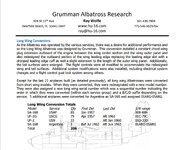I'm looking at converting the Trumpeter 1/48 HU-16A Albatross to an HU-16B (more specifically, an RCAF CSR-110).
I plan on using S2F cowls, engines and props for the correct powerplants, and 'bulging' the nacelles.
I'm aware of the wing and wingtip extensions, the larger span horizontal stab, and the taller tail, but I'm coming up short on some info ...
While the horizontal stab span was increased (with redesigned elevators), was the chord increased also, if so, by how much.
Also, the 'cuffed' leading edge to eliminate the slots in front of the aileron, how far out along the wing did it start?
Is there anything else I should be aware of?

Thanks,
Colin
I plan on using S2F cowls, engines and props for the correct powerplants, and 'bulging' the nacelles.
I'm aware of the wing and wingtip extensions, the larger span horizontal stab, and the taller tail, but I'm coming up short on some info ...
While the horizontal stab span was increased (with redesigned elevators), was the chord increased also, if so, by how much.
Also, the 'cuffed' leading edge to eliminate the slots in front of the aileron, how far out along the wing did it start?
Is there anything else I should be aware of?
Thanks,
Colin

